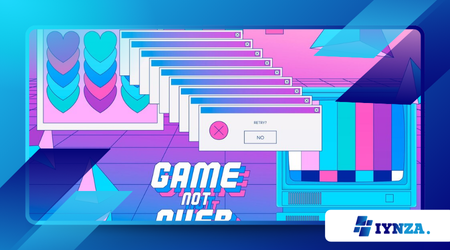De los píxeles a las obras maestras: la evolución de los gráficos de los juegos retro

El mundo de los videojuegos ha recorrido un largo camino desde sus inicios. Lo que una vez consistió en Personajes pixelados simples y entornos en forma de bloques se ha transformado en Mundos visualmente impresionantes y muy detallados que rivalizan con las películas animadas.
Anuncios
Pero el El encanto de los gráficos de juegos retro permanece atemporal, recordándonos una época en la que La creatividad prosperó dentro de estrictas limitaciones tecnológicas.
Desde Sprites de 8 bits de la NES hacia Pixel art hecho a mano de la era de los 16 bitsLa evolución de los gráficos de los juegos retro es un testimonio de innovación, arte y nostalgia. Pero ¿cómo llegamos desde allí? Desde píxeles simplistas hasta obras maestras que dieron forma a la industria del juego.? En este artículo, exploraremos el avances técnicos, técnicas artísticas e impacto duradero de los gráficos de juegos retro.
El nacimiento del Pixel Art: Los primeros días de los gráficos para videojuegos
Antes de que los juegos evolucionaran en el mundos ultrarrealistas de alta definición Vemos hoy que todo empezó con Pequeños píxeles en forma de bloques que forman personajes y entornos. en una pantalla. En el momento, Los primeros juegos tenían limitaciones gráficas; Por lo tanto, los desarrolladores tuvieron que pensar creativamente con las herramientas limitadas que tenían.
A pesar de estas limitaciones, el nacimiento de pixel art en los juegos condujo a Algunos de los diseños más icónicos y memorables en la historia de los videojuegos. y, La simplicidad de los primeros gráficos no obstaculizó la narración ni la inmersión. En cambio, animó a los jugadores a Usa su imaginación para completar los detalles., lo que hace que estos juegos sean singularmente atractivos.
A medida que avanzaba la tecnología de los juegos, El pixel art se convirtió rápidamente en una característica definitoria de los primeros videojuegos. En particular, Permitió a los desarrolladores crear Personajes distintivos, mundos de juego reconocibles y efectos visuales innovadores a pesar de las limitaciones del hardware.
Desde las máquinas recreativas hasta las consolas domésticas, el estilo visual de los juegos basados en píxeles Cautivó a los jugadores y sentó las bases para el futuro de los gráficos de juegos..
También te podría gustar: Lo último en tecnología de juegos: desde consolas hasta juegos en la nube
1. Las limitaciones del hardware inicial
En las décadas de 1970 y 1980, el hardware para juegos era... extremadamente limitado en memoria, potencia de procesamiento y capacidades gráficas. Los desarrolladores de juegos tuvieron que trabajar con Colores mínimos, resoluciones bajas y sprites simples..
- Atari 2600 (1977) – Los gráficos fueron Rudimentario, basado en líneas y formas simples.
- Máquinas recreativas (principios de la década de 1980) – Juegos como Pac-Man y Donkey Kong introducido sprites de personajes y fondos desplazables.
- Nintendo Sistema de entretenimiento (NES) (1985) – Con un 8 bits procesadorLa NES revolucionó los gráficos de los juegos, permitiendo... Pixel art detallado y animación de desplazamiento lateral.
A pesar de estas limitaciones, los primeros desarrolladores empujó los límites de lo que era posible, creando personajes y mundos icónicos que siguen siendo amados hoy en día.
2. El arte de los gráficos de 8 bits
El Era de los 8 bits (NES, Sega Master System) introducido pixel art definido, donde cada uno Cada píxel fue colocado con cuidado para formar personajes, ambientes y objetos.
- Super Mario Bros. (1985) - Usado colores brillantes y contrastantes para crear personajes y niveles distintos.
- La leyenda de Zelda (1986) - Presentado arte de píxeles de estilo aventura de arriba hacia abajo, mejorando y construyendo el mundo.
- Mega Man (1987) – Exhibido Animaciones de personajes fluidas y fondos detallados. a pesar de las limitaciones de hardware.
Revolución de 16 bits: una nueva era del pixel art
1. Paletas de colores y animación aumentadas
Con la introducción de Consolas de 16 bits (Super Nintendo, Sega Genesis), los desarrolladores tuvieron acceso a Paletas de colores más ricas, mejor resolución y animación más fluida.
- Trabajo de sprites más detallado permitido para sombreado, degradados y profundidad en diseños de personajes.
- desplazamiento de paralaje creó la ilusión de profundidad al superposición de elementos de fondo.
- Tamaños de sprites más grandes permitió personajes más expresivos y entornos más detallados.
2. Ejemplos clásicos del arte de 16 bits
Algunos de los juegos visualmente más impactantes surgieron de la era de los 16 bits:
- Súper Metroid (1994) – Creó un mundo atmosférico de ciencia ficción Utilizando sombreado de píxeles detallado y animaciones suaves.
- Chrono Trigger (1995) – Exhibido Impresionantes sprites de personajes y entornos detallados., estableciendo nuevos estándares para los juegos de rol.
- Sonic el erizo (1991) - Usado Animaciones de movimiento rápido y colores brillantes. para mejorar la fluidez del juego.
El La era de los 16 bits consolidó el pixel art como un verdadero medio artístico, con muchos juegos que aún hoy son elogiados por su artesanía y atractivo visual.
La transición al 3D: ¿el fin de la era del píxel?
1. El auge de los gráficos basados en polígonos
A mediados de los años 90, los videojuegos pasaron de... Arte de píxeles 2D a gráficos poligonales 3D, gracias a los avances en la tecnología de las consolas:
- Sony PlayStation (1994) y Nintendo 64 (1996) introducido Entornos 3D y modelos de personajes.
- Juegos como Super Mario 64 y Final Fantasy VII fue pionero por completo Jugabilidad en 3D y narrativa cinematográfica.
- Los polígonos texturizados reemplazaron a los sprites tradicionales, lo que permite un mayor realismo pero sacrifica el detalle artesanal del pixel art.
Mientras muchos abrazaron Las nuevas posibilidades del 3D, otros se perdieron el Precisión y control artístico de gráficos basados en píxeles 2D.
2. El declive del pixel art tradicional en los videojuegos convencionales
A medida que los juegos entraron en el principios de la década de 2000El pixel art se convirtió en Menos común en los principales lanzamientos de juegos., reemplazado por:
- Modelos 3D de alta resolución con animación de captura de movimiento.
- Motores de iluminación y física realistas.
- Escenas de corte CGI pre-renderizadas que imitaba la producción cinematográfica.
Si bien el pixel art ya no era el estilo dominante, él nunca desapareció realmente. En cambio, es Encontró un nuevo hogar en los juegos independientes y proyectos de inspiración retro..
El renacimiento moderno de los gráficos retro
1. La escena de los videojuegos independientes y el regreso del pixel art
Con el auge de desarrolladores de juegos independientesEl pixel art experimentó una resurgimiento masivo. Muchos juegos independientes modernos abrazar la estética retro mientras se benefician de tecnología avanzada.
- Undertale (2015) – Combinado Gráficos nostálgicos de 8 bits con mecánicas narrativas modernas.
- Celeste (2018) – Exhibido Animación fluida y expresiva de pixel art, lo que demuestra que los gráficos de píxeles aún pueden evolucionar.
- El caballero hueco (2017) – Mezclado Estética dibujada a mano con una sensación pixelada, creando una experiencia visualmente rica.
Estos juegos demostraron que El pixel art no es solo una reliquia del pasado: sigue siendo una poderosa opción artística..
2. ¿Por qué los jugadores todavía aman los gráficos retro?
A medida que la tecnología de los juegos continúa... impulsar el realismo gráfico, hay un Encanto y arte innegables en gráficos basados en píxeles. Los jugadores valoran:
- Nostalgia: Muchos jugadores crecieron con Imágenes de 8 y 16 bits, haciéndolos reconocibles instantáneamente.
- Atemporalidad: A diferencia de los primeros modelos 3D, El pixel art no envejece mal—sigue siendo visualmente atractivo décadas después.
- Estética única: El sencillez y naturaleza estilizada Los gráficos de píxeles ofrecen una identidad artística distintiva.
Preguntas frecuentes (FAQ)
1. ¿Por qué los primeros gráficos de los videojuegos estaban tan pixelados?
Los primeros hardware para juegos tenían limitaciones gráficas, lo que requiere que los desarrolladores trabajen con Pantallas de baja resolución y paletas de colores limitadas.
2. ¿Cuál fue el primer juego en utilizar pixel art?
Algunos de los primeros juegos, como Invasores del espacio (1978) y Pac-Man (1980), usado gráficos de píxeles básicos debido a restricciones de hardware.
3. ¿Por qué el pixel art sigue siendo popular hoy en día?
El pixel art es Visualmente atractivo, nostálgico y adaptable., lo que lo convierte en un Estilo preferido para juegos independientes y proyectos de inspiración retro..
4. ¿Cuáles son los juegos de pixel art más emblemáticos?
Clásicos como Super Mario Bros., La leyenda de Zelda, Chrono Trigger, y Final Fantasy VI se consideran obras maestras del pixel art.
5. ¿El pixel art desaparecerá algún día por completo de los videojuegos?
¡Improbable! El pixel art se ha convertido en un estilo artístico respetado., y muchos desarrolladores continúan adoptándolo en juegos modernos.
Conclusión
La evolución de gráficos de juegos retro es un viaje que muestra tanto el progreso tecnológico como la innovación artística. De Desde sprites pixelados simples hasta obras maestras de píxeles bellamente elaboradasLas imágenes de los juegos han avanzado mucho, pero su El legado sigue siendo más fuerte que nunca.
Mientras Los juegos modernos llevan el realismo gráfico a nuevos niveles, el El encanto eterno del pixel art continúa inspirando tanto a desarrolladores de juegos como a jugadores..
Ya sea que se trate de clásicos nostálgicos o nuevas joyas indieLas imágenes basadas en píxeles demuestran que El verdadero arte trasciende la tecnología.
